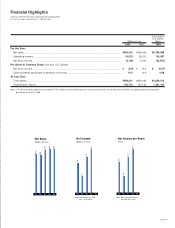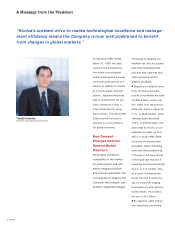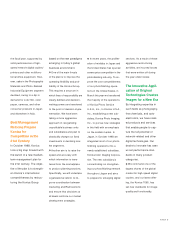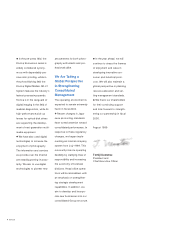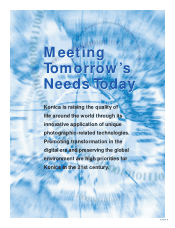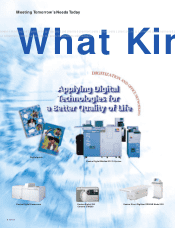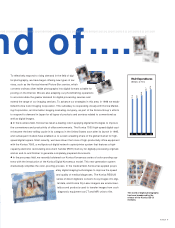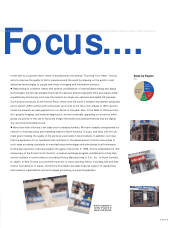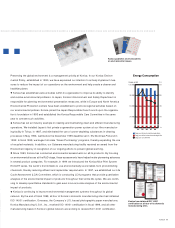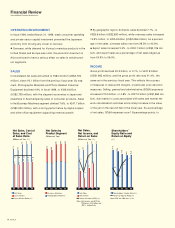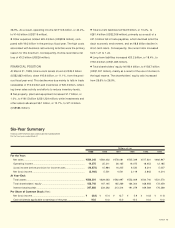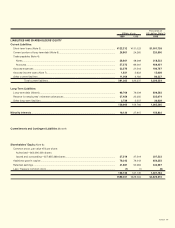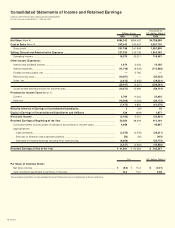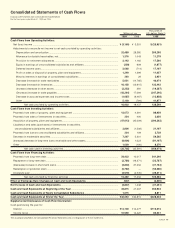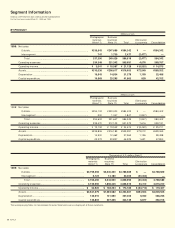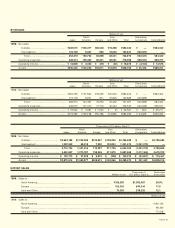Konica Minolta 1999 Annual Report Download - page 15
Download and view the complete annual report
Please find page 15 of the 1999 Konica Minolta annual report below. You can navigate through the pages in the report by either clicking on the pages listed below, or by using the keyword search tool below to find specific information within the annual report.
KONICA 11
Energy Consumption
0
30,000
60,000
90,000
120,000
0
80
90
100
110
’94 ’95 ’96 ’97 ’98
(%)
Crude oil (kl)
Energy use at all domestic manufacturing subsidiaries
Energy use at all Konica domestic manufacturing facilities
Energy use to sales (1994=100)
...
0101010001010000000000000010101000001010100011111000010101000101011011010101010111010101011101010
Preserving the global environment is a management priority at Konica. In our Konica Environ-
mental Policy, established in 1990, we have expressed our intention to actively implement mea-
sures to reduce the impact of our operations on the environment and help create a cleaner and
healthier planet.
RKonica has established various bodies within its organization to improve its ability to identify
and resolve environmental problems. In Japan, Konica’s Environment and Safety Department is
responsible for planning environmental preservation measures, while in Europe and North America
Environmental Protection centers have been established to promote regional activities based on
our environmental policies. Konica joined the Japan Responsible Care Council upon the organiza-
tion’s foundation in 1995 and established the Konica Responsible Care Committee in the same
year to oversee such activities.
RKonica has set an industry example in creating and maintaining clean and efficient manufacturing
operations. We installed Japan’s first private cogeneration power system at our Hino manufactur-
ing facility in Tokyo, in 1987, and eliminated the use of ozone-depleting substances in cleaning
processes in May 1993, well before the December 1995 deadline set in The Montreal Protocol in
1992. In fiscal 1999, we began full-scale “Green Purchasing” programs, thereby expanding the use
of recycled materials. In addition, our Odawara manufacturing facility received an award from the
Environment Agency in recognition of our ongoing efforts to prevent global warming.
RSince 1993, Konica has conducted environmental assessments on all its products. By focusing
on environmental issues at the R&D stage, these assessments have helped make pioneering advances
in several product categories. For example, in 1994 we introduced the Konica Nice Print System
ECOJET series, the world’s first minilabs to use environmentally sound tablet-form photofinishing
chemicals, thereby reducing effluent and replenisher requirements. In 1997, we established our Life
Cycle Assessment (LCA) Committee, which is conducting LCA programs that provide quantitative
analyses of the environmental impact of products throughout their entire life cycles. We are contin-
uing to develop quantitative standards to gain even more accurate analyses of the environmental
impact of products.
RKonica is continuing to improve environmental management systems throughout its global
network. By the end of fiscal 1999, all four of Konica’s domestic manufacturing sites had obtained
ISO 14001 certification. Overseas, the Company’s U.S.-based photographic paper manufacturer,
Konica Manufacturing U.S.A., Inc., received ISO 14001 certification in fiscal 1999, and all other
manufacturing bases in Konica’s global network are working to receive ISO 14001 certification.
Konica has obtained ISO 14001
certification at all four of its domestic
manufacturing sites.
Konica publishes several booklets
on environmental issues.


